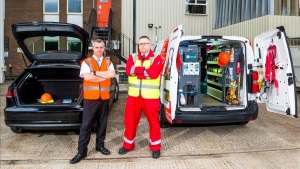Complete Powerpoint slide presentation for forklift instructors. Ready made training course
a thorough examination is down to the tools
 The following article about forklift truck thorough examinations is by CFTS and gives a good overview of how a thorough examination should be carried out.
The following article about forklift truck thorough examinations is by CFTS and gives a good overview of how a thorough examination should be carried out.
A Thorough Examination provider should inspect all safety-critical parts as required by LOLER and PUWER regulations. It’s the law.
That means checking the entire vehicle from the top of a truck mast to the belly plate.
But this isn’t a case of kicking the tyres and giving everything a cursory once-over. Proper measurements need to be taken to ensure the truck is working within the legal safety guidelines. And that requires specialist tools.
Inspection providers accredited to the CFTS Thorough Examination scheme will never make assumptions regarding the safety of your truck. Uniquely, they come fully equipped with a wide range of specialist tools designed to deliver accurate, replicable measurements that show exact increments of wear.
Importantly, in many cases, the evidence can be viewed by the truck owner. This transparency means you can be confident that your equipment has been examined in detail, and that it is safe to use, but also that chains, etc. are not being replaced or repaired prematurely.
Here are some of the key things that should appear in a Thorough Examination provider’s toolkit.
Fork wear gauge: Precisely measures the percentage of wear (between 0-10%) on fork heels.
Chain wear gauge: Accurately measures leaf chain and roller chain wear by indicating the percentage of elongation. This will show you how close your chains are to needing a replacement.
Digital or manual vernier caliper: Uses a calculation formula to measure wear on fork heels.
Fork wear caliper: Checks fork angle, fork hooks and fork blade maximum wear (only 10% and above).
Digital angle protractor and set square: Measures fork angles to ensure damaged or bent forks do not go beyond manufactured limits (typically +/- 3 degrees).
Other kit typically carried by a CFTS-accredited examiner (and very few others) includes: a harness for working at height, truck blocks to secure equipment, torches to inspect defects, UV torches for crack detection, toe jacks for better access, ratchet straps to secure masts and forks, mast blocks for checking wear on mast pivot brushes and for securing equipment during steering inspections, cones or barriers to ensure inspections take place in segregated areas, rulers and tape measures.
If your inspection provider doesn’t come equipped with these, there is every chance your truck is not being inspected thoroughly and to the very highest standard.
Disclaimer. The legislative information contained on this web site is my interpretation of the law based on many years in the health and safety business. A definitive interpretation can only be given by the courts. I will therefore not be held responsible for any accident/incident/prosecution arising as a consequence of anyone using any information obtained from this web site.